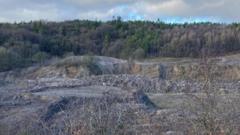Will Reopening a Quarry Ruin This Scenic Paradise?

Plans to Extend Dormant Quarry in AONB Sparks Controversy
The proposal to extend the operational life of Burley Hill Quarry in Eryrys, Denbighshire, has ignited heated debates among local communities, environmental groups, and local authorities. As Tarmac Trading Ltd seeks to continue limestone extraction for another 15 years, concerns about the environmental impact, noise pollution, and the disruption of local tourism have dominated discussions. This article delves into the various facets of the proposed quarry extension, the arguments for and against it, and the overarching implications for the Area of Outstanding Natural Beauty (AONB) that envelops the site.
The Context of Burley Hill Quarry
Burley Hill Quarry has a long history, with its operational life spanning from 1950 to 2021. Initially, it served as a vital source of limestone, a material essential for construction and various industrial processes. However, the quarry closed two decades ago, and since then, the surrounding area has undergone significant transformation. New businesses have emerged, many of which rely heavily on the region's tourism appeal—an aspect that is now threatened by the potential reopening of the quarry.
The Proposal: What Tarmac Trading Ltd Is Seeking
Tarmac Trading Ltd has submitted an application to extend the quarry's life, proposing to extract 3.8 million tonnes of limestone. The company argues that there is a demonstrable need for the mineral that would outweigh any temporary disruption caused by the quarrying activities. According to planning officers, this need for limestone is critical, especially given the potential consequences of leaving the mineral reserves unworked.
The Planning Process and Public Consultation
The Denbighshire council's planning committee has twice delayed discussions on this application to allow for further public consultation, demonstrating the significance of community input in the planning process. The planning officers have recommended granting permission to Tarmac Trading Ltd, citing the necessity of extracting minerals to meet local and regional demands.
Community Opposition and Environmental Concerns
The prospect of reopening Burley Hill Quarry has drawn opposition from various stakeholders, including:
- Community councils from Llanferres, Llanarmon-yn-Ial, and Nercwys
- Mold Town Council
- The AONB's joint advisory committee
- Ramblers Cymru
These groups have raised concerns over multiple issues, including:
- Noise Pollution: The resumption of quarrying activities would lead to increased noise, disrupting the tranquility that characterizes the AONB.
- Increased Traffic: Heavy vehicles associated with quarry operations could congest local roads, posing safety risks for pedestrians and cyclists.
- Environmental Impact: The extraction process could harm local wildlife and ecosystems, particularly in an area recognized for its natural beauty.
- Tourism Risks: The quarry's operations could deter tourists, who are vital for local businesses and the economy.
Political Responses and Community Sentiment
Members of the Senedd have expressed their concerns regarding the quarry's reopening, highlighting the recent changes in the area and the potential implications for local businesses. Sam Rowland, Carolyn Thomas, Darren Millar, Llyr Gruffydd, Hannah Blythyn, and Mark Isherwood have all raised objections. Millar, representing Clwyd West, pointed out how the landscape has evolved over the last 20 years, emphasizing the need to prioritize local businesses that thrive on tourism.
Moreover, a local petition against the quarry extension has garnered over 400 signatures, reflecting the community's discontent with the proposal. The AONB advisory committee has articulated that reopening the quarry would have a "significant adverse impact" on local tranquility, potentially diminishing the area's natural beauty.
Arguments in Favor of the Quarry Extension
Proponents of the quarry extension, including planning officers, present several arguments in favor of the proposal:
- Essential Resource: Limestone is crucial for various construction projects, and the local demand for this mineral necessitates its extraction.
- Mitigation Strategies: The planning report suggests that any temporary harm to the AONB's tranquillity can be mitigated through careful planning and operational management.
- Reduced Intensity: The proposed operations would operate at a lesser intensity, with a reduced output compared to the quarrying activities prior to its closure in 2005.
Environmental Management and Mitigation Measures
In response to the concerns raised, Tarmac Trading Ltd has proposed several mitigation measures aimed at minimizing environmental impact:
- Noise Reduction: Implementation of noise barriers and scheduling operations during specific hours to minimize disturbances.
- Traffic Management: Developing traffic management plans to ensure the safety of local residents and visitors.
- Environmental Monitoring: Ongoing assessment of local wildlife and ecosystems to ensure compliance with environmental standards.
The Broader Implications for the AONB
The Clwydian Range and Dee Valley AONB is a region celebrated for its stunning landscapes and biodiversity. It attracts tourists from near and far, providing a substantial economic boost to local businesses. The ongoing debate around the quarry extension raises critical questions about the balance between resource extraction and conservation. How can communities ensure that essential materials are available while also preserving the natural beauty and integrity of their surroundings?
Future of the AONB: A Balancing Act
As the planning committee prepares to make a decision on Tarmac Trading Ltd's application, it is vital to consider the long-term implications of quarry operations in an AONB. The challenge lies in finding a balance that meets both economic and environmental needs. Stakeholders from all sides must engage in constructive dialogue to explore alternatives that support local economies without compromising the natural environment.
Conclusion: The Path Forward
The decision regarding the future of Burley Hill Quarry is not merely about the extraction of limestone; it encapsulates broader themes of environmental stewardship, community welfare, and economic needs. As discussions continue, the voices of local residents, policymakers, and environmental advocates will play a pivotal role in shaping the outcome.
As concerned citizens, stakeholders, and decision-makers reflect on this issue, one question looms: how can we prioritize the health of our communities and the environment while still addressing the essential resource needs of the present and future? The debate continues, and the implications of the decision will resonate within the community for years to come.
FAQs
What is an Area of Outstanding Natural Beauty (AONB)?
An AONB is a designated area in the UK recognized for its natural beauty, where special planning policies apply to conserve and enhance the landscape and environment.
What are the primary concerns of opponents to the quarry extension?
Opponents are mainly concerned about noise pollution, increased traffic, environmental damage, and potential negative impacts on local tourism.
What is the expected output of limestone extraction if the quarry is allowed to reopen?
Tarmac Trading Ltd plans to extract 3.8 million tonnes of limestone over the proposed 15-year extension period.
In light of the complexities surrounding this issue, how can we ensure sustainable practices that support both local economies and the environment? #AONB #SustainableDevelopment #CommunityEngagement
Published: 2025-07-12 11:00:15 | Category: wales



